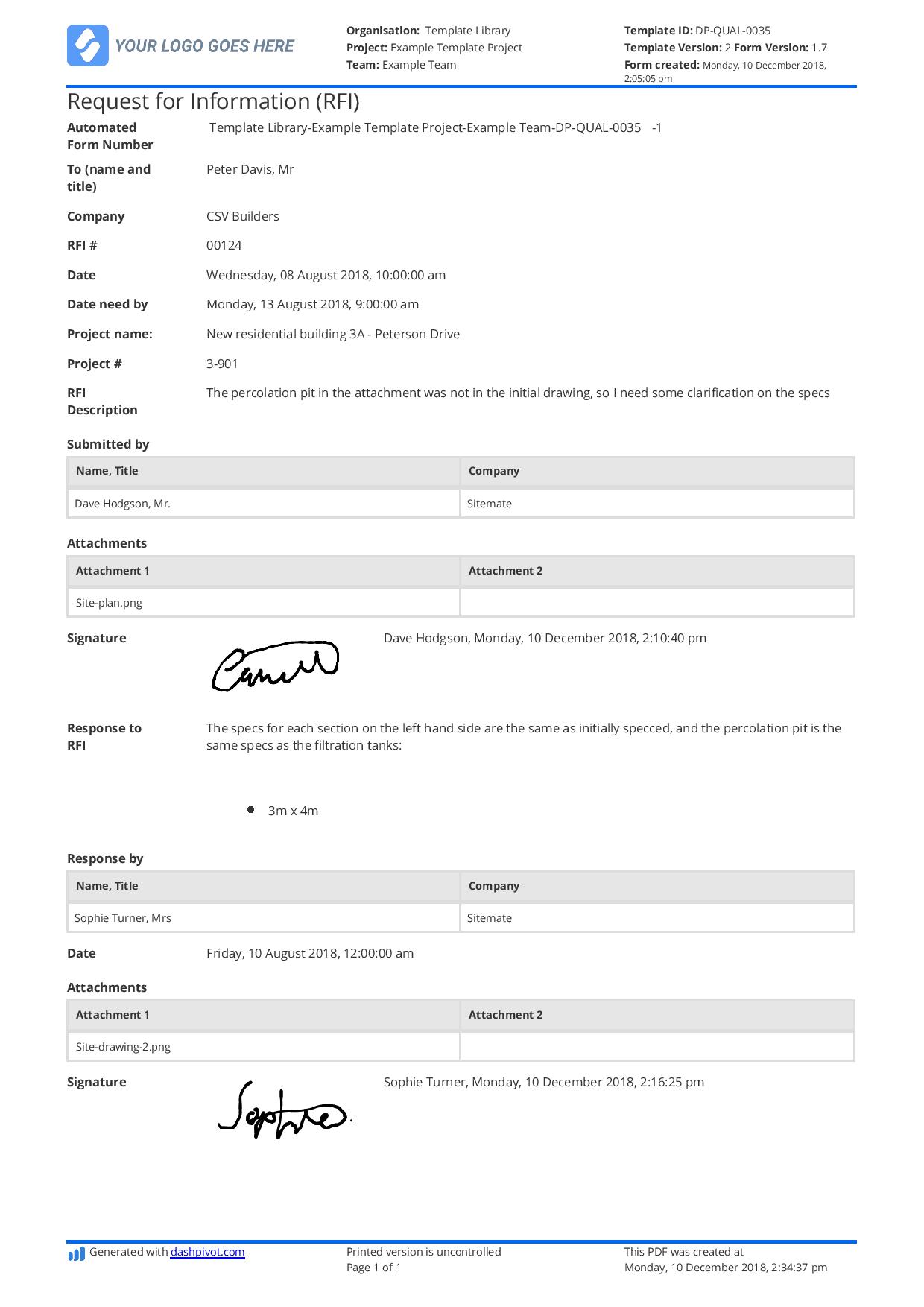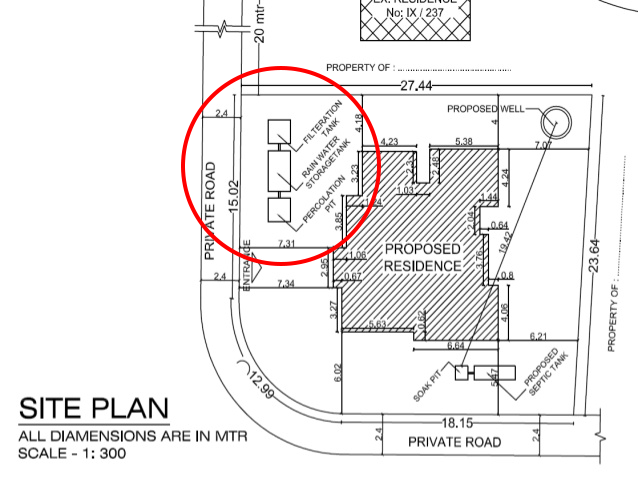Quality – Request for information example
RFI construction example (request for information)
In this article, we'll show a Request for Information (RFI) construction example to help resolve ambiguities, like clarifying drawings or approving materials, to prevent delays and errors, and we cover the best practices for drafting, submitting, and resolving RFIs, using real-world scenarios.

What is an RFI in construction?
An RFI in construction is a document which is created and issued by one project party to another to get clarification on a specific part of a construction project such as the construction plans, specifications, contract clauses and building standards.
An RFI is a clarification and supplemental information often required in construction projects where no matter how well a project is planned and scoped out, there is always room for some interpretation and often a number of changes and variations which need to be accounted for.
The general use case for a construction RFI to get more detail about aspects of the project which cannot be easily interpret from the original plans and to make substitutions where required.
RFIs in construction are most commonly issued by contractors to architects and vice versa, and between contractors and subcontractors. The request for information serves as a formal written record of the request issued from the 'issuer' and the RFI response from the respondent.
Without the acting intermediary, this communication and collaboration would be taking place on a verbal and more informal level, leaving more room for interpretation and disputes later down the road.
So we understand what an RFI in construction means and is used for - now let's see an example construction RFI.
An RFI in construction example
When it becomes clear to a subcontractor or contractor that there is some piece of work or a specification which is unclear - and after some preliminary research to try and find the 'answer' - they will issue a request for information to the appropriate project party who can answer their request and make sure the project moves forward properly.
RFIs are extremely important documents, but they are also a time-consuming and administrative headache, requiring a number of documents and rounds of feedback between parties. While these requests and this back and forth is necessary to avoid major issues later on, it also creates project delays which can be frequent and tangible.
In order to minimise and mitigate the time it takes to coordinate requests for information, it is important to have a standardised and repeatable RFI process which you know works well and keeps projects moving forward swiftly.
At the core of this process is your RFI form. The form is the mechanism for communicating the request and answering the request. It is the way that multiple parties come to a conclusion as to what the outcome of the request should be.
So maintaining a standardised RFI template helps you keep strong records of all of these interactions and changes while also making sure that requests and responses get seen and heard.
The below RFI example looks like many of the forms and documents you use on construction projects.
The first part of the request for information form is record keeping information for your own internal needs and for external issues and audits:
- Automated form number to keep everyone of your RFIs unique
- Who the RFI is issued to and their company
- A unique RFI #
- The date that the RFI is issued and the date it is needed by
- The project name and project number
The rest of the document is about describing the request for information in detail i.e what is the information needed. It is important to be as explicit as possible in this description, and add supporting drawings and documents which help to explain the information which is being sought out.
You'll notice that there are two sections on this example RFI. The first section is for the issuer, and the second sections is for the response. The issues and respondent have sections for their own signatures and for adding attachments to try ensure there is no questioning whether things have been seen or not.

Use and customise this RFI example for your own company and projects.
Example construction RFI letter
The other method of communicating your requests for information is to write a formal letter (less commonly used and less recommended) - which some companies also attach to the above form.
The RFI letter format will be very similar to the RFI form format, and it should be succinct and objective.
Take a look at the example letter below, which can be easily used and customised for your company and projects.
RFI number:
To (name and title):
Company:
Date:
Date information is needed by:
Project name:
Project number:
REQUEST FOR INFORMATION DESCRIPTION
Lorem ipsum dolor sit amet, consectetur adipiscing elit, sed do eiusmod tempor incididunt ut labore et dolore magna aliqua. Ut enim ad minim veniam, quis nostrud exercitation ullamco laboris nisi ut aliquip ex ea commodo consequat.
See attached documents for supporting information.
Signed by,
Authorised Person
Obviously if you create and manage your RFIs in this way, the respondent will have to write a clarifying letter back, which increases the time to project progress. But this method does still work and is typically okay if you are dealing with a small and infrequent number of RFIs.
How to easily streamline your request for information process
If you are a contractor or subcontractor who is managing high frequencies and critical requests for information on a regular basis, then it may be worth your time to look at a dedicated RFI tool or software.
As has been previously mentioned, simply communicating and managing these project communications can require serious time and resources, so it can save a lot of time you are able to simplify and automate much of this process while also standardising the process to reduce risk and improve your records.
There are 3 or 4 time-consuming elements of the RFI process which can be drastically improved via software:
- Your RFI form: You can create a standardised and digital template for creating RFIs. This template can be accessed and completed from anywhere and on any device (mobile, tablet etc.)
- Your RFI process: You can automate the time-consuming collaboration and back and forth of RFIs. Setup workflows where the appropriate party is notified when an RFI is waiting for their comments, information and approval so nothing ever gets missed.
- Your RFI records and evidence: Keep all of your supporting attachments, PDFs with markups and photos and videos attached to RFIs and available within the platform
- Tracking and analysing RFIs: Keep track of where all of your RFIs are at in the process via workflows, registers and dashboards. Build charts which have real-time data about all of your RFIs including their status and who these RFIs are coming from.

Above is an example of an RFI workflow. You can see that three (3) RFIs are sitting with the general contractor while three (3) more are in the process of being completed and sitting with the engineer. The final two (2) RFIs have been answered and closed out.
Bringing this type of simple and powerful automation to your internal and external workflows saves incredible amounts of time whilst improving the way that you collaborate every day.
If you are producing a number of RFIs, this type of software can take the vast majority of admin and time required to manage the process, allowing you to focus on getting answers (or giving answers) quickly and getting on with important project work.
You can get started with the RFI example below, or can learn more about this quality management software here.

RFI Construction template
This RFI (request for information) template makes your RFI process quick, easy and automated to keep your projects moving forward.

Site Inspection template
Use this site inspection template for any site inspection (safety, quality, environmental) to make inspections faster, easier and more organised.

Progress Claim template
Streamline and automate the progress claim process to get paid faster and look more professional.
